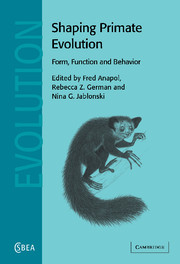Book contents
- Frontmatter
- Contents
- List of contributors
- Preface: shaping primate evolution
- 1 Charles Oxnard: an appreciation
- Part I Craniofacial form and variation
- Part II Organ structure, function, and behavior
- Part III In vivo organismal verification of functional models
- Part IV Theoretical models in evolutionary morphology
- Part V Primate diversity and evolution
- Index
Part III - In vivo organismal verification of functional models
Published online by Cambridge University Press: 10 August 2009
- Frontmatter
- Contents
- List of contributors
- Preface: shaping primate evolution
- 1 Charles Oxnard: an appreciation
- Part I Craniofacial form and variation
- Part II Organ structure, function, and behavior
- Part III In vivo organismal verification of functional models
- Part IV Theoretical models in evolutionary morphology
- Part V Primate diversity and evolution
- Index
Summary
Though it would appear from my early work that I primarily used anatomical inference for the “functional” explanations for the morphological, especially morphometric, adaptations that I saw in my studies, I nevertheless was always interested in the “real” biomechanics, interested in testing, that is, the hypotheses resulting from anatomical inference. The best that we could do at the time for the shoulder was to rely on the pioneering electromyographic studies on the human shoulder carried out by Inman, Saunders, and Abbott during the Second World War. Doing electromyography on nonhuman primates seemed such a long shot in those days.
Yet in fact my first research grant (from the US Public Health Service as it was called then), awarded in 1962 while I was still in the UK, aimed in part to design an implantable telemetric device for recording electromyographic and strain-gauge information from freely moving primates. Stanley Salmons was the research fellow employed on that grant for that purpose. But of course, only a few weeks' reading was enough to demonstrate that we could not do it – it just was not possible to make the device small enough for that purpose in those days. Stanley Salmons, however, did go on to design the “buckle transducer'” a first device for measuring tension in tendons, so all was not lost. He is today Professor of Biomedical Engineering at the University of Liverpool and has been engaged in these latter years in studies making the latissimus dorsi muscle into an adjunct pump in cases of cardiac insufficiency.
- Type
- Chapter
- Information
- Shaping Primate EvolutionForm, Function, and Behavior, pp. 227 - 228Publisher: Cambridge University PressPrint publication year: 2004

